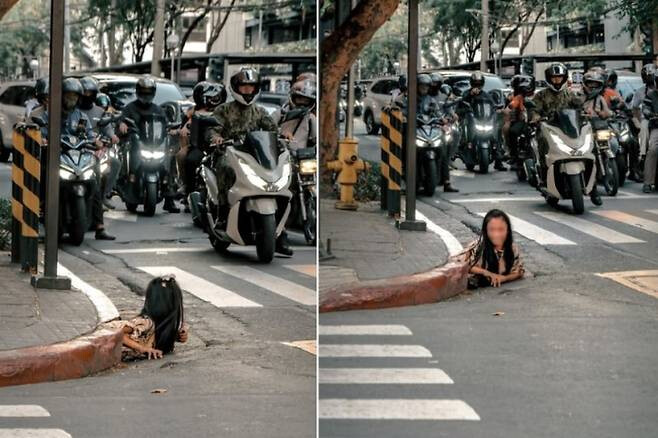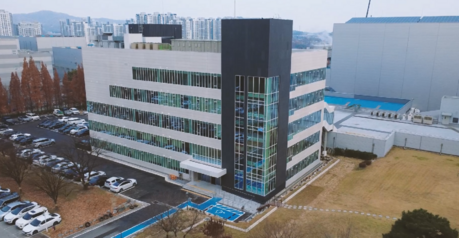
On May 26, an amateur photographer captured a photo in the bustling Makati financial district of Manila, the Philippines, that sent shockwaves across the nation. The photo depicted a woman, clad in a dirt-stained blouse and torn denim shorts, emerging from a sewer. Her long hair, matted with dirt and dried leaves as if unwashed for a long time, vividly underscored her grim reality.
This striking photo quickly went viral after being posted on Instagram, garnering over 1,400 likes and being reported by local news, accumulating over 2 million views. The photographer noted that many passersby and drivers watched in stunned silence as the woman hurriedly disappeared.
A Scene from a Horror Movie, or the Stark Reality of Philippine Poverty?
As the photo spread, various reactions flooded online regarding this bizarre sight. Some netizens expressed shock, likening it to Sadako, the ghost from the horror movie "The Ring," emerging from a well, or Pennywise, the evil clown from the movie "It," lurking in a street sewer.
However, a more poignant observation was that the woman unequivocally represented Manila's dire poverty, particularly the lives of the homeless. With over 3 million of Manila's approximately 14 million inhabitants estimated to be homeless, the Philippines faces a severe poverty issue. These individuals are known to seek refuge wherever they can lay their bodies down—in shanties, on pushcarts, on the streets, or even in cemeteries, drains, and sewer tunnels. Thus, the photo was not merely a "strange scene" but a painful facet of Philippine society's undeniable reality.
The Truth About 'Rose': Not Living in the Sewer, But Retrieving a Lost Cutter
As the photo became a social issue, Philippine President Ferdinand Marcos immediately instructed government authorities to ascertain the woman's condition and devise support measures. The Philippine Department of Social Welfare and Development (DSWD) swiftly located the woman, identified as 'Rose,' in a Manila slum.
Rose gave a shocking explanation during her interview with DSWD officials. She clarified that she was not living in the sewer and had only temporarily entered it to retrieve a cutter knife she had accidentally dropped. For Rose, who typically earns a living by collecting and selling trash, the cutter knife was a crucial tool for her livelihood. Local police authorities added that homeless individuals like Rose often use sewer pipes as passages and indeed found various items, including shirts, in the sewer from which Rose emerged. This revelation transformed what initially seemed like a mere "weird photo" into a poignant illustration of the survival methods of the Philippines' poor.
Philippine Government's Promise of Support and Efforts Towards Sustainable Self-Sufficiency
As Rose's story gained attention, social interest in helping her intensified. Social Welfare and Development Secretary Rex Gatchalian personally met with Rose on May 29 and promised support. Secretary Gatchalian stated that the DSWD would provide 80,000 Philippine pesos (approximately 2 million Korean Won) to help Rose open a small general store in her neighborhood, enabling her to secure a stable income.
Furthermore, upon learning that Rose's husband possessed welding skills but was unemployed, leading them to live on the streets together, the Secretary pledged to assist in linking him to job opportunities. The government's proactive intervention is interpreted as an effort to establish a foundation for Rose's family to become self-sufficient, extending beyond temporary assistance.
The Question 'Rose's' Story Poses: The Unending Problem of Poverty
A single photo of Rose emerging from a Manila sewer brought the profound issue of poverty in Philippine society to the forefront. Although Rose was not a homeless person residing in the sewer, her story vividly illustrated the reality of the impoverished—those who sell trash to survive and are compelled to enter sewers to retrieve valuable tools for their livelihood.
Using this incident as a catalyst, the Philippine government must devise more fundamental support measures for the poor and strive to ensure they can lead sustainable lives. 'Rose's' story is not just a mere incident; it delivers an important message, urging us to reconsider the lives of countless individuals hidden in the back alleys of bustling cities. We must not forget that the problem of poverty in the Philippines is not confined to Rose alone but is the reality of countless others who continue to live in dark and uncomfortable places, much like a sewer, even at this very moment.
[Copyright (c) Global Economic Times. All Rights Reserved.]






























